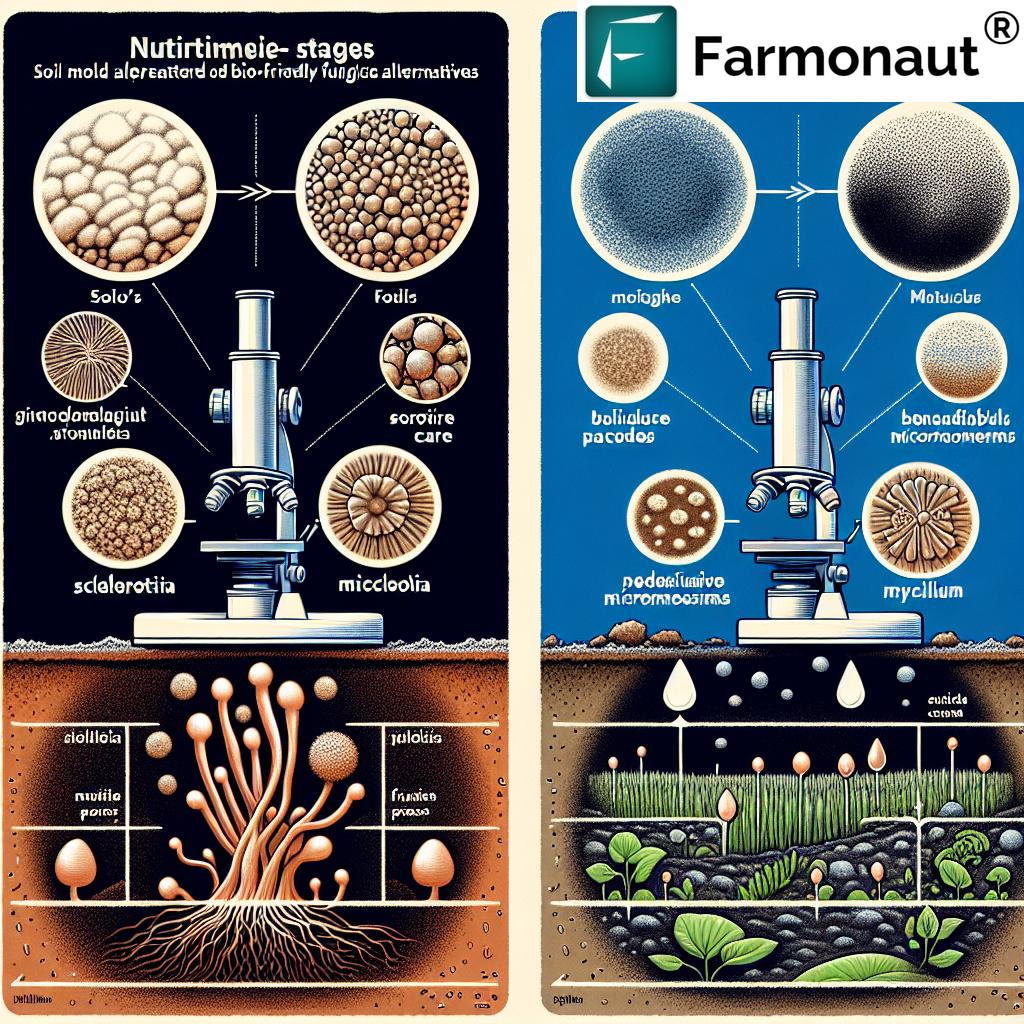Organic White Mold Treatment: Expert Guide to Protecting Your Crops Naturally
“White mold, caused by Sclerotinia sclerotiorum, can affect over 400 plant species, including eggplants, strawberries, and tomatoes.”
Welcome to our comprehensive guide on organic white mold treatment! As experts in sustainable agriculture and natural pest control methods, we at Farmonaut understand the challenges farmers face when combating fungal diseases like white mold. In this article, we’ll explore effective strategies for managing Sclerotinia sclerotiorum, a persistent soil-borne pathogen that affects a wide range of crops. Our focus will be on organic fungal disease control techniques that align with sustainable agriculture practices, ensuring the health of your plants and the environment.

Understanding White Mold: The Silent Crop Killer
White mold, scientifically known as Sclerotinia sclerotiorum, is a formidable adversary in the world of agriculture. This fungal disease can wreak havoc on a variety of crops, including:
- Vegetables: Eggplants, tomatoes, peppers, cabbage, cauliflower, peas, beans, lettuce, cucumber, squash, melon, pumpkin, zucchini, and watermelon
- Fruits: Strawberries
- Herbs: Basil, tarragon, and mint
The lifecycle of white mold is complex and understanding it is crucial for effective management. Let’s break it down:
- Survival in Soil: Sclerotia, the hardy resting structures of the fungus, can survive in soil for years, waiting for optimal conditions.
- Germination: When conditions are right (usually cool and moist), sclerotia germinate to form apothecia.
- Spore Dispersion: Apothecia release ascospores into the air, which can travel and infect plants.
- Infection: Spores land on plant tissues, especially during flowering, and begin to grow if moisture is present.
- Mycelium Growth: The fungus develops a white, cottony mycelium that spreads through plant tissues.
- Sclerotia Formation: New sclerotia form within infected plant parts, ready to start the cycle again.
Understanding this lifecycle is key to implementing effective organic white mold treatment strategies. By targeting different stages of the fungus’s development, we can create a comprehensive management plan.
The Impact of White Mold on Crops
White mold can have devastating effects on crop yield and quality. Some of the impacts include:
- Wilting and collapse of plant stems
- Rotting of fruits and vegetables
- Reduced photosynthesis due to leaf damage
- Decreased crop yield
- Post-harvest losses in storage
The economic impact of white mold can be significant, making prevention and control crucial for sustainable farming practices.
Organic White Mold Treatment Strategies
Now that we understand the enemy, let’s explore organic white mold treatment options that align with sustainable agriculture practices:
1. Cultural Control Methods
Cultural control is the foundation of organic pest management. These techniques focus on creating an environment unfavorable for white mold development:
- Crop Rotation: Implement a 3-4 year rotation with non-host crops to reduce sclerotia in soil.
- Plant Spacing: Proper spacing improves air circulation, reducing humidity within the plant canopy.
- Irrigation Management: Use drip irrigation or water early in the day to allow foliage to dry quickly.
- Weed Control: Remove weeds that can serve as alternate hosts for the fungus.
- Resistant Varieties: Choose crop varieties with known resistance to white mold when available.
These methods form the backbone of a holistic approach to white mold management.
2. Biological Control Agents
Biological control agents are living organisms that can help suppress white mold. Some effective options include:
- Coniothyrium minitans: A fungus that parasitizes sclerotia in the soil.
- Bacillus subtilis: A beneficial bacterium that can inhibit fungal growth.
- Trichoderma species: Fungi that compete with Sclerotinia for resources and can parasitize it.
These biological controls offer a natural and sustainable way to manage white mold in organic farming systems.

3. Organic Fungicides
While chemical fungicides are not an option in organic farming, there are several organic alternatives that can be effective against white mold:
- Copper-based products: Effective but should be used judiciously to avoid copper buildup in soil.
- Sulfur: Can be applied as a preventative measure.
- Neem oil: A natural fungicide with multiple modes of action.
- Potassium bicarbonate: Alters pH on leaf surfaces, making them inhospitable to fungi.
Always follow organic certification guidelines when using these products.
4. Essential Oils
Certain essential oils have shown promise in controlling white mold:
- Tea tree oil: Has antifungal properties effective against Sclerotinia sclerotiorum.
- Thyme oil: Contains compounds that can inhibit fungal growth.
- Oregano oil: Another potent antifungal option.
These oils can be diluted and applied as foliar sprays, offering a natural and aromatic approach to white mold control.
“Organic white mold treatments using tea tree oil and Bacillus subtilis can reduce fungal infections by up to 70% in some crops.”
5. Soil Management
Healthy soil is crucial for plant resilience against diseases like white mold. Consider these soil management practices:
- Composting: Adds beneficial microorganisms that can compete with pathogens.
- Cover Cropping: Improves soil structure and can break disease cycles.
- Reduced Tillage: Minimizes soil disturbance, preserving beneficial soil ecology.
- Soil Solarization: Using solar heat to reduce pathogen populations in soil.
These practices contribute to overall soil health, making plants more resistant to diseases.
Integrating Technology in White Mold Management
At Farmonaut, we believe in harnessing the power of technology to enhance agricultural practices. Our satellite-based crop monitoring system can be a valuable tool in managing white mold:
- Early Detection: Our advanced imaging can identify potential problem areas before symptoms are visible to the naked eye.
- Moisture Monitoring: Track soil moisture levels to optimize irrigation and reduce conditions favorable for white mold development.
- Crop Health Tracking: Monitor overall crop health to ensure plants are resilient against diseases.
By integrating these technological solutions with organic management practices, farmers can create a robust defense against white mold.
Explore our Farmonaut Web App for cutting-edge crop monitoring solutions.
Implementing a Holistic White Mold Management Plan
Effective white mold control requires a multi-faceted approach. Here’s a step-by-step guide to implementing a comprehensive management plan:
- Assessment: Evaluate your farm’s history with white mold and identify high-risk areas.
- Prevention: Implement cultural control methods as your first line of defense.
- Monitoring: Regularly inspect crops and use technology like Farmonaut’s satellite imaging for early detection.
- Intervention: Apply organic treatments at the first sign of infection or as a preventative measure in high-risk situations.
- Evaluation: Assess the effectiveness of your strategies and adjust as needed.
Remember, consistency and vigilance are key to successful white mold management in organic farming systems.
Comparison of Organic White Mold Treatment Methods
| Treatment Method | Effectiveness | Application Frequency | Best For | Pros | Cons |
|---|---|---|---|---|---|
| Tea Tree Oil | Medium | Weekly | Most vegetables and herbs | Natural, aromatic, multi-purpose | Can be expensive, may phytotoxic if concentrated |
| Bacillus subtilis | High | Bi-weekly | Broad spectrum of crops | Long-lasting, improves soil health | Slow initial action, requires specific conditions |
| Crop Rotation | Medium-High | Seasonal | All affected crops | Improves soil health, breaks disease cycle | Requires long-term planning, may reduce cash crop area |
| Moisture Management | High | Continuous | All crops | Preventative, improves overall plant health | Requires careful monitoring, may be challenging in wet climates |
| Biological Fungicides | Medium-High | As needed | Most vegetables and fruits | Environmentally friendly, specific to target pathogens | May be less effective in severe infestations, can be costly |
This table provides a quick reference for various organic white mold treatment methods, helping you choose the most suitable approach for your specific farming situation.
The Role of Technology in Organic White Mold Management
At Farmonaut, we’re committed to integrating cutting-edge technology with traditional farming practices to enhance crop protection strategies. Our satellite-based monitoring system offers several advantages in managing white mold:
- Precision Monitoring: Our technology allows for precise tracking of crop health indicators, helping identify potential white mold outbreaks before they become severe.
- Data-Driven Decision Making: By providing real-time data on crop conditions, soil moisture, and weather patterns, we empower farmers to make informed decisions about when and where to apply organic treatments.
- Resource Optimization: Our system helps optimize the use of organic fungicides and biological controls by pinpointing areas that need attention, reducing waste and improving efficacy.
Discover how our API can integrate advanced monitoring into your farming operations.
By leveraging technology, organic farmers can enhance their white mold management strategies, leading to healthier crops and improved yields.
Future Trends in Organic White Mold Control
As we look to the future of organic farming and white mold management, several exciting trends are emerging:
- Bioengineered Resistant Crops: Development of naturally resistant varieties through advanced breeding techniques.
- Nanotechnology: Exploring nanoparticles for more effective delivery of organic treatments.
- AI and Machine Learning: Advanced predictive models for disease outbreaks and treatment optimization.
- Microbiome Engineering: Enhancing beneficial soil microorganisms to naturally suppress white mold.
At Farmonaut, we’re committed to staying at the forefront of these innovations, integrating them into our platform to provide farmers with the most advanced tools for organic white mold management.
Explore our API Developer Docs to see how you can integrate our advanced monitoring solutions into your farming tools.
Conclusion: Empowering Organic Farmers Against White Mold
Organic white mold treatment is a complex but manageable challenge in sustainable agriculture. By combining cultural practices, biological controls, organic treatments, and advanced technology, farmers can effectively protect their crops from this persistent pathogen. Remember, the key to success lies in a holistic, integrated approach that prioritizes prevention and early intervention.
At Farmonaut, we’re dedicated to supporting organic farmers in their fight against white mold and other crop diseases. Our satellite-based monitoring system, coupled with expert agricultural insights, provides a powerful tool for modern, sustainable farming practices.
By staying informed, vigilant, and open to innovative solutions, organic farmers can not only manage white mold but thrive in an era of sustainable agriculture. Together, we can cultivate healthier crops, protect our environment, and ensure a bountiful future for generations to come.
FAQ: Organic White Mold Treatment
Q: What is the most effective organic treatment for white mold?
A: While effectiveness can vary depending on the specific situation, a combination of cultural practices (like proper spacing and moisture management) and biological controls (such as Bacillus subtilis) often yields the best results in organic systems.
Q: How often should I apply organic fungicides for white mold control?
A: Application frequency depends on the product and severity of the problem. Generally, treatments are applied every 7-14 days during high-risk periods. Always follow the manufacturer’s recommendations and organic certification guidelines.
Q: Can crop rotation completely eliminate white mold?
A: While crop rotation is a powerful tool, it may not completely eliminate white mold due to the pathogen’s ability to survive in soil for years. However, a well-planned rotation can significantly reduce disease pressure over time.
Q: How can Farmonaut’s technology help in managing white mold?
A: Farmonaut’s satellite-based monitoring system can help detect early signs of crop stress, track soil moisture levels, and provide data-driven insights for timely interventions, all of which are crucial for effective white mold management.
Q: Are there any natural predators of white mold that can be used in organic farming?
A: Yes, certain fungi like Coniothyrium minitans are natural parasites of Sclerotinia sclerotiorum and can be used as biocontrol agents in organic farming systems.






